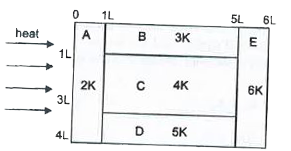The ends of the two rods of conductivities , radii and lengths in the ratio of 1:2 are maintained at the same temperature difference. If the rate of flow through the bigger rod is 12 cal s−1, in shorter it will be (in cal s−1) : Solution in Kannada
1
2
3
4
The correct Answer is:C
H=Qt=kA(T1−T2)d
∴H1=k1A1(T1−T2)d1
H2=k2A2(T1−T2)d2
∴H1H2=k1k2⋅A1A2×d2d1=12×(12)2×21=14
∴H1=H2×14=12×14=3 cal s−1.
Thus correct choice is (c ).
Topper's Solved these Questions
- BOOK - MODERN PUBLICATIONCHAPTER - TRANSFERENCE OF HEAT EXERCISE - Multiple Choice Questions (Level - III) Questions From AIEEE/JEE Examination)5videos
TRANSFERENCE OF HEAT
- BOOK - MODERN PUBLICATIONCHAPTER - TRANSFERENCE OF HEAT EXERCISE - Recent Competitive Questions4videos
TRANSFERENCE OF HEAT
- BOOK - MODERN PUBLICATIONCHAPTER - TRANSFERENCE OF HEAT EXERCISE - Recent Competitive Questions4videos
TRANSFERENCE OF HEAT
- BOOK - MODERN PUBLICATIONCHAPTER - SOLIDS & SEMICONDUCTOR DEVICESEXERCISE - Revision Test28videos
SOLIDS & SEMICONDUCTOR DEVICES
- BOOK - MODERN PUBLICATIONCHAPTER - UNIFORM CIRCULAR MOTIONEXERCISE - Revision Test57videos
UNIFORM CIRCULAR MOTION
Similar Questions
A composite block is made of slabs A,B,C,D and E of different thermal conductivities (given in terms of a constant K) and sizes (given in terms of length, L) as shown in the figure. All slabs are of same width. Heat 'Q' flows only from left to right through the blocks.
Then in steady state
 02:10View Solution
02:10View SolutionTwo slabs are of the thicknesses d1 and d2. Their thermal conductivities are K1 and K2 respectively They are in series. The free ends of the combination of these two slabs are kept at temperatures θ1 and θ2. Assume θ1>θ2. The temperature θ of their common junction is
02:05View SolutionTwo slabs are of the thicknesses d1 and d2. Their thermal conductivities are K1 and K2 respectively They are in series. The free ends of the combination of these two slabs are kept at temperatures θ1 and θ2. Assume θ1>θ2. The temperature θ of their common junction is
02:11View SolutionChoose the forward biased p-n junction :
05:01View SolutionA sphere of mass m is tied to end of a string of length 1 and rotated through the other and along a horizontal circular path with speed . The work done in full horizontal circle is:
04:15View SolutionThe end of two rods of different materials with their thermal conductivities, area of cross-section and lengths all in the ratio 1:2 are maintained at the same temperature difference. If the rate of flow of heat in the first rod is 4 cal//s . Then, in the second rod rate of heat flow in cal//s will be
02:39View SolutionThe heat is flowing through two cylinderical rods of same material. The diameters of the rods are in the ratio 1:2 and their lengths are in the ratio 2:1 . If the temperature difference between their ends is the same, the ratio of rates of flow of heat through them will be
02:35View SolutionTwo cylindrical rods of same meterial have the same temperature difference between their ends. The ratio of rates of flow of heat through them is 1 : 8. The ratio of the radii of the rods are 1 : 2. What is the ratio of their lengths ?
01:35View SolutionThe heat is flowing through two cylindrical rods of same material. The diameters of the rods are in the ratio 1:2 and their lengths are in the ratio 2:1. If the temperature difference between their ends is the same, the ratio of rate of flow of heat through them will be
02:29View SolutionThe ends of two rods of different materials with their thermal conductivities, radii of cross sections and lengths all in the ratio 1 : 2 are maintained at the same temperature difference, if the rate of flow of heat in the larger rod is 4 cal/ sec, the rate of flow of heat in the shorter rod will be
03:12View SolutionThe ends of the two rods of different materials with their lengths, diameters of cross-section and thermal conductivities all in the ratio 1 : 2 are maintained at the same temperature difference. The rate of flow of heat in the shorter rod is 1cals^(-1) . What is the rate of flow of heat in the larger rod:
02:55View SolutionHeat is flowing through two cylindrical rods of the same material. The diameters of the rods are in the ratio 1:2 and the lengths in the ratio 2:1. If the temperature difference between the ends be the same, then the ratio of the rate of flow of heat through them will be :
View SolutionThe ends of a cylinder steel rod are maintained at two different temperatures. The rod conducts heat from one end to the other at a rate of 10 cal // s. At what rate would a steel rod twice as long and twice the diameter conduct heat between the same two temperatures?
View SolutionHeat is flowing through two cylindrical rods of the same material . The diameters of the rods are in the ratio 1:2 and the lengths in the ratio 2:1.If the temperature difference between the ends be the same ,then the ratio of the rate of flow if heat through them will be ?
02:55View SolutionThe ratio of radii of two cylindrical rods of same material is 2 : 1 and ratio of their lengths is 2 : 3. Their ends are maintained at same temperature difference. If rate of flow of heat in the longer rod is 2 Cal s−1, then that in the shorter rod will be
View Solution

